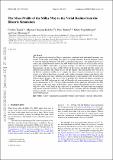| dc.contributor.author | Taylor, Corbin | |
| dc.contributor.author | Boylan-Kolchin, Michael | |
| dc.contributor.author | Hernquist, Lars | |
| dc.contributor.author | Torrey, Paul A. | |
| dc.contributor.author | Vogelsberger, Mark | |
| dc.date.accessioned | 2017-05-01T18:35:57Z | |
| dc.date.available | 2017-05-01T18:35:57Z | |
| dc.date.issued | 2016-06 | |
| dc.date.submitted | 2016-06 | |
| dc.identifier.issn | 0035-8711 | |
| dc.identifier.issn | 1365-2966 | |
| dc.identifier.uri | http://hdl.handle.net/1721.1/108549 | |
| dc.description.abstract | We use particle data from the Illustris simulation, combined with individual kinematic constraints on the mass of the Milky Way (MW) at specific distances from the Galactic Centre, to infer the radial distribution of the MW's dark matter halo mass. Our method allows us to convert any constraint on the mass of the MW within a fixed distance to a full circular velocity profile to the MW's virial radius. As primary examples, we take two recent (and discrepant) measurements of the total mass within 50 kpc of the Galaxy and find that they imply very different mass profiles and stellar masses for the Galaxy. The dark-matter-only version of the Illustris simulation enables us to compute the effects of galaxy formation on such constraints on a halo-by-halo basis; on small scales, galaxy formation enhances the density relative to dark-matter-only runs, while the total mass density is approximately 20 per cent lower at large Galactocentric distances. We are also able to quantify how current and future constraints on the mass of the MW within specific radii will be reflected in uncertainties on its virial mass: even a measurement of M(<50 kpc) with essentially perfect precision still results in a 20 per cent uncertainty on the virial mass of the Galaxy, while a future measurement of M(<100 kpc) with 10 per cent errors would result in the same level of uncertainty. We expect that our technique will become even more useful as (1) better kinematic constraints become available at larger distances and (2) cosmological simulations provide even more faithful representations of the observable Universe. | en_US |
| dc.description.sponsorship | United States. National Aeronautics and Space Administration (NNX14AH35G) | en_US |
| dc.language.iso | en_US | |
| dc.publisher | Oxford University Press | en_US |
| dc.relation.isversionof | http://dx.doi.org/10.1093/mnras/stw1522 | en_US |
| dc.rights | Creative Commons Attribution-Noncommercial-Share Alike | en_US |
| dc.rights.uri | http://creativecommons.org/licenses/by-nc-sa/4.0/ | en_US |
| dc.source | arXiv | en_US |
| dc.title | The mass profile of the Milky Way to the virial radius from the Illustris simulation | en_US |
| dc.type | Article | en_US |
| dc.identifier.citation | Taylor, Corbin; Boylan-Kolchin, Michael; Torrey, Paul; Vogelsberger, Mark and Hernquist, Lars. "The mass profile of the Milky Way to the virial radius from the Illustris simulation." Monthly Notices of the Royal Astronomical Society 461, no. 4 (June 2016): 3483-3493. | en_US |
| dc.contributor.department | Massachusetts Institute of Technology. Department of Physics | en_US |
| dc.contributor.department | MIT Kavli Institute for Astrophysics and Space Research | en_US |
| dc.contributor.mitauthor | Torrey, Paul A. | |
| dc.contributor.mitauthor | Vogelsberger, Mark | |
| dc.relation.journal | Monthly Notices of the Royal Astronomical Society | en_US |
| dc.eprint.version | Author's final manuscript | en_US |
| dc.type.uri | http://purl.org/eprint/type/JournalArticle | en_US |
| eprint.status | http://purl.org/eprint/status/PeerReviewed | en_US |
| dspace.orderedauthors | Taylor, Corbin; Boylan-Kolchin, Michael; Torrey, Paul; Vogelsberger, Mark; Hernquist, Lars | en_US |
| dspace.embargo.terms | N | en_US |
| dc.identifier.orcid | https://orcid.org/0000-0002-5653-0786 | |
| dc.identifier.orcid | https://orcid.org/0000-0001-8593-7692 | |
| mit.license | OPEN_ACCESS_POLICY | en_US |
